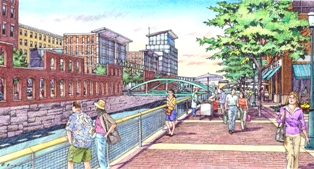Canal project will transform city

Fast forward a decade and this could be you, strolling along what is now a neglected area bordered on the north by the National Park Service lot off Dutton Street and on the south by Middlesex and Revere Streets. This morning, City Manager Bernie Lynch introduced Trinity Financial, master planner for the renovation of the Hamilton Canal District, to about 100 members of the community. The conceptual drawing shown above is a view from the lot which incorporates the original brick wall that exists today with new pedestrian-friendly bridges and wide sidewalks. Key factors of the Hamilton Canal District project include respect for the site’s historical significance, waterways, and environmental aspects, as well as making connections to the existing downtown and public transportation system. Touted as the most important development the city has undertaken since the Tsongas Arena and the baseball stadium, the completed project is expected to nearly double the size of the downtown, increase tax revenue by $2.2 million, and provide new jobs, residents, and businesses. Today’s meeting launched a series of informational sessions with the community that will continue over the next nine months. These charrettes (a French word defined by Trinity as an “intensive, collaborative, public-planning process to produce a shared vision”) are designed to get community input on the project. The planning process will include forming community groups to work on issues such as housing, retail, history, and open space. Ground breaking is projected for 2009, with the entire project taking up to 10 years to complete. Trinity, a firm that claims to “listen well,” appears to have a proven track record for accomplishing complex projects. For instance, they built an attractive, mixed-use space (housing, commercial, and parking) on top of an MBTA subway line in Boston. They also won a national award last year for a mixed-residential project in East Boston. Renovating the Hamilton Canal District will cost about a half billion dollars. (Not much was said today about financing other than the great partnership between the city, state, and private interests.) The project’s potential to transform the city makes it worth investing our own vision for what that future may be.